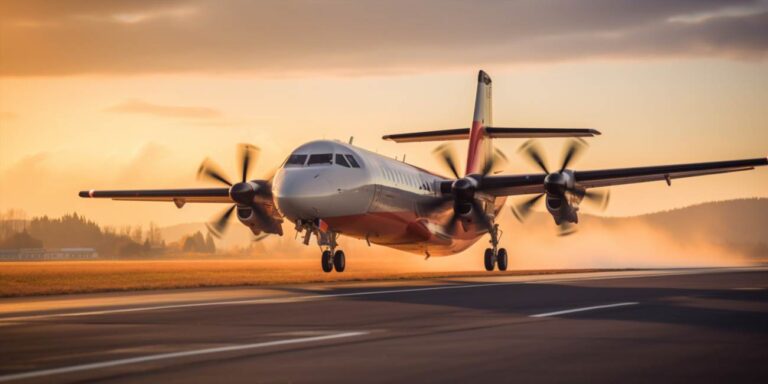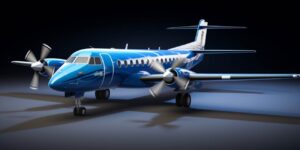One of the defining features of the ATR 72 is its versatility. Tailored to cater to short to medium-haul routes, this aircraft boasts a capacity ranging from 70 to 78 passengers, making it an optimal choice for connecting regional destinations with utmost convenience. Its adaptability is underscored by its ability to navigate a diverse range of airports, including those with shorter runways, thus enhancing accessibility to various regions.
The aircraft’s design places a premium on fuel efficiency, aligning with contemporary environmental consciousness. The incorporation of advanced turboprop engines contributes to reduced fuel consumption and lower emissions. This not only translates to economic benefits for airlines but also signifies a commitment to sustainable aviation practices.
Stepping into the ATR 72’s cabin reveals a thoughtfully designed interior that prioritizes passenger comfort. The spacious seating arrangement ensures a pleasant journey, while large windows offer panoramic views, contributing to an overall enjoyable flying experience. The aircraft’s interior is not just aesthetically pleasing but also functional, with modern amenities catering to the evolving expectations of passengers.
The technological prowess of the ATR 72 is evident in its avionics and navigation systems. Equipped with state-of-the-art technology, including digital cockpits and advanced communication systems, the aircraft ensures a high level of safety and operational efficiency. Pilots benefit from comprehensive situational awareness, further enhancing the reliability of the aircraft.
As an emblem of reliability, the ATR 72 has solidified its position in the regional aviation landscape. Renowned for its operational flexibility, economic viability, and commitment to sustainability, this aircraft continues to play a pivotal role in connecting communities and fostering regional development.
The history and development of the atr 72 over the years
The ATR 72, a twin-engine turboprop short-haul regional airliner, has a rich history and development that spans several decades. It was first introduced by Aerospatiale and Alenia Aeronautica in the late 1980s, with its maiden flight taking place on October 27, 1988. The aircraft was designed as an extension of the highly successful ATR 42, aiming to accommodate a larger number of passengers.
The ATR 72 quickly gained popularity for its versatility and efficiency in regional air travel. One of its standout features is its ability to operate on short runways, making it suitable for airports with limited infrastructure. The aircraft’s twin-turboprop engines, supplied by Pratt & Whitney Canada, contribute to its fuel efficiency and reliability, making it a preferred choice for many regional airlines.
Over the years, the ATR 72 has undergone several upgrades and enhancements to meet evolving aviation standards. Notable variants include the ATR 72-500, which introduced improvements in avionics and aerodynamics, and the subsequent ATR 72-600, featuring the latest technological advancements.
With a focus on passenger comfort, the interior of the ATR 72 has seen modifications to enhance the flying experience. Airlines have the flexibility to configure the cabin layout based on their preferences, offering options for different seating capacities and configurations. The aircraft’s spacious cabin and large windows contribute to a pleasant journey for passengers.
The ATR 72 has played a crucial role in connecting smaller cities and remote regions, where larger aircraft might be impractical. Its economic operational costs and ability to serve underdeveloped airfields have made it an essential asset for regional airlines worldwide. This has led to its widespread adoption, with airlines across Europe, Asia, and Latin America incorporating the ATR 72 into their fleets.
As the aviation industry continues to evolve, the ATR 72 remains a reliable workhorse, contributing to the growth of regional air connectivity. Its combination of efficiency, versatility, and passenger comfort positions it as a key player in the regional aviation market. With ongoing advancements and updates, the ATR 72 is expected to maintain its status as a preferred choice for regional airlines in the years to come.
The design and key features that make the atr 72 unique
The ATR 72 stands out in the realm of regional aircraft, boasting a design that seamlessly blends efficiency and performance. Let’s delve into its distinctive features, starting with the wings. Crafted with precision, the wings of the ATR 72 are not just aerodynamic marvels but also pivotal in enhancing fuel efficiency. The fuselage, meticulously designed for optimal aerodynamics, complements the wings, contributing to the aircraft’s overall stability and fuel economy.
Now, let’s soar into the heart of the ATR 72 – the engines. Equipped with powerful turboprop engines, this aircraft excels in both speed and fuel efficiency. The cockpit, a technological cockpit marvel, reflects an ergonomic design aimed at providing pilots with a seamless and intuitive flying experience. The integration of cutting-edge avionics and navigation systems ensures precise control and navigation, further enhancing the overall safety of the aircraft.
The fuselage of the ATR 72 is not merely a structural component; it embodies a harmonious blend of robustness and weight efficiency. Constructed with advanced materials, the fuselage contributes to the aircraft’s durability while keeping weight at an optimum level. This balance is a key factor in the ATR 72’s ability to operate economically over short to medium-haul routes, making it a preferred choice for regional airlines.
As we delve into the performance metrics of the ATR 72, it becomes evident that this aircraft is a paragon of efficiency. Its well-designed wings and aerodynamic fuselage play a crucial role in achieving impressive fuel efficiency figures. The powerful engines propel the aircraft to commendable speeds while maintaining a balance between performance and environmental responsibility.
The future of the enduringly popular atr 72 model
The future of the enduringly popular ATR 72 model holds promising prospects with a series of planned upgrades and improvements aimed at enhancing its overall efficiency while maintaining a keen eye on cost considerations.
One of the key elements in the future roadmap for the ATR 72 involves a comprehensive set of upgrades to its avionics suite. Advanced navigation systems, enhanced communication capabilities, and state-of-the-art cockpit displays are on the horizon. These improvements not only elevate the aircraft’s technological profile but also contribute to increased operational efficiency.
In terms of structural enhancements, the future iterations of the ATR 72 are expected to incorporate improvements that optimize aerodynamics, reducing drag and thereby enhancing fuel efficiency. These changes not only align with the industry’s growing emphasis on sustainability but also translate into tangible cost savings for operators through reduced fuel consumption.
Furthermore, the future models of the ATR 72 are set to embrace cutting-edge materials and manufacturing processes, leading to weight reductions without compromising structural integrity. This, coupled with advanced engine technologies, contributes to a substantial boost in fuel efficiency, a critical factor in the evolving landscape of aviation where environmental concerns and operational cost-effectiveness go hand in hand.
The focus on operational efficiency extends beyond the aircraft itself. ATR is actively exploring and integrating innovative maintenance and servicing solutions, leveraging data-driven technologies. Predictive maintenance algorithms, real-time monitoring, and proactive component replacement strategies are anticipated upgrades that not only enhance reliability but also have a positive impact on the overall cost of ownership.
With an eye on the future, the ATR 72’s avionics and connectivity are expected to undergo a significant transformation. The integration of advanced communication systems not only enhances in-flight capabilities but also opens avenues for improved operational coordination, contributing to a holistic efficiency paradigm.






